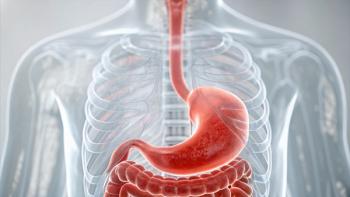
Nirogacestat Significantly Reduces Pain Severity in Patients With Desmoid Tumors
Nirogacestat significantly reduced pain scores for patients with desmoid tumors.
Patients with desmoid tumors experienced significant and clinically meaningful reductions in pain following treatment with the investigational gamma secretase inhibitor nirogacestat, according to data from 3 patient-reported outcome assessments collected during the phase 3 DeFi trial (NCT03785964).1
Findings presented at the
At cycle 10 of treatment, BPI-SF assessment indicated a significant 1.55-point decrease (standard error [SE]=0.26) in the severity of tumor-related “worst pain ''with nirogacestat vs 0.05 points (SE =0.27) with placebo (one-sided P < .001). Overall change from baseline for patients who received nirogacestat was 1.57 points (SE=0.22) vs 0.26 points (SE=0.27) with placebo (one-sided P < .001). The proportion of patients who achieved a clinically meaningful reduction in pain with nirogacestat, as evidenced by a decrease from baseline of 2.0 points or greater at cycle 10, was 68.2%. This percentage was 26.3% with placebo (odds ratio [OR], 6.08; 95% CI, 1.95-18.98; one-sided P = .001).
According to data from the GODDESS-DTSS test, mean baseline pain score at cycle 10 was reduced by 1.78 points (SE = 0.27) with nirogacestat. Notably, patients reported a 0.34 point (SE = 0.28) increase in pain with placebo (one-sided P < .001). A clinically meaningful reduction in pain (decrease of 1.9 points or greater) was observed in 58.7% of patients in the experimental arm vs 18.9% with placebo (OR, 6.24; 95% CI, 2.16-17.99; one-sided P < .001) at this time point.Patients reported an overall 1.89 (SE = 0.22) decrease and 0.064 increase (SE = 0.23) in pain with nirogacestat and placebo, respectively (one-sided P < .001).
Lastly, mean baseline pain was reduced by 22.36 points at cycle 10 in the nirogacestat group according to the EORTC QLQ-C30 pain subscale. Patients given placebo reported a 7-point increase (SE=3.65) in pain (one-sided P < .001). Pain scores decreased by 21.66 points (with nirogacestat (SE = 2.53) and 2.33 points (SE = 2.63) with placebo (SE = 2.63) overall (one-sided P < .001).
“The benefits of nirogacestat vs placebo in reducing pain were consistent across multiple patient-completed assessment tools, which supports the robustness of these conclusions,” study co-author Timothy Bell, MHA, of SpringWorks Therapeutics, said in a poster presentation on the data.
Pain is one of the most frequent and debilitating symptoms seen in patients with desmoid tumors and can often indicate disease progression, according to Bell. Accordingly, pain reduction is an important treatment goal for this population. To address this concern, the DeFi trial was designed to evaluate the efficacy and safety of nirogacestat in adults with desmoid tumors.
The global, double-blind, randomized, placebo-controlled trial enrolled patients 18 years of age or older who had histologically confirmed desmoid tumors with disease progression. Patients were required to be treatment naïve and ineligible for surgery or have experienced recurrent or refractory disease after one prior line of therapy. The data cutoff for the primary analysis was April 7, 2022.2
Primary findings from the DeFi trial were previously reported at the 2022 ESMO Annual Congress, and were recently published in the New England Journal of Medicine. Patients with progressing desmoid tumors were shown to experience a statistically significant improvement in progression-free survival (PFS) with nirogacestat (n = 70) vs placebo (n = 72; HR, 0.29; 95% CI, 0.15–0.55; P< .001). Nirogacestat also reduced the risk of disease progression or death by 71% vs placebo.Notably, an analysis of “worst pain” via the Brief Pain Inventory Short Form (BPI-SF) showed that nirogacestat also reduced the severity of pain by 1.5 points on a 10-point scale (P < .001).2The agent had a manageable safety profile and reported treatment-emergent adverse events (TEAEs) were predominantly grade 1 or 2.3
Based on these findings,
A total of 142 patients were enrolled on the trial from May 2019 to April 2020. Of these, 72 patients were assigned to receive 150 mg of oral nirogacestat twice daily, and 70 patients received twice-daily placebo.2 Treatment was given continuously in 28-day cycles until disease progression, trial discontinuation, death, or trial completion.1
Seven days prior to cycle 1 of treatment, patients began daily baseline assessments. Patients were given 3 prespecified assessment tools to complete electronically at home: the BPI-SF, the GOunder/Desmoid Tumor Research Foundation DEsmoid Symptom (GODDESS-DTSS) Scale, the and European Organization for Research and Treatment of Cancer Core Quality of Life Questionnaire (EORTC QLQ-C30). BPI-Sf and GODDESS-DTSS assessments were scored on a scale of 1 to 10, while the EORTC QLQ-C30 assessment was scored from 1 to 100. Collectively, assessments evaluated worst pain, dull pain, shooting pain, pain, and pain interference with activities of daily living. These assessments were completed monthly and continued until treatment cessation.
At cycle 10, investigators compared changes from baseline pain scores between treatment arms using a mixed model for repeated measures. A stratified Cochran-Mantel-Haenszel test was administered at this time to compare the proportion of patients with a clinically meaningful reduction in pain according to prespecified thresholds. Cycle 10 was preselected as the time point for analysis to ensure adequate time for a potential treatment effect to occur.
The primary end point of the DeFi study was PFS per blinded independent central review RECIST v1.1 criteria. Key secondary and exploratory end points included objective response rate, duration of response , quality of life, tumor volume changes as assessed by MRI, and the incidence of adverse effects. Changes in patient-reported outcomes for pain, symptom burden, and physical and role function were also assessed.2
The median age was 33.5 (range 18-73) in the nirogacestat arm and 34.5 (range 18-76) in the placebo arm. In the experimental arm, 64% (n = 45) of patients identified as female and 36% (n = 25) identified as male. These percentages were 65% (n = 47) and 35% (n = 25) in the placebo arm.Twenty-four percent of patients (n = 17) in the experimental arm had intra-abdominal tumors vs 25% (n = 18) of patients in the placebo arm; 76% (n = 53) and 75% (n = 54) of patients in each respective arm had extra-abdominal tumors. Regarding focal category, 39% (n = 27) of patients in the experimental arm had a multi-focal tumor vs 43% (n = 31) of patients in the placebo arm. The remaining patients in each arm had a single tumor. Median target tumor size was 91.6 mm (range 64.7-134.1) in the nirogacestat arm and 115.7 in the placebo group (73.5-161.7). 1
At baseline, 39% and 43% of patients reported uncontrolled pain according to the BPI-SF in the nirogacestat and placebo groups, respectively. Patients who went on to receive nirogacestat had a mean BPI-SF “worst pain” score of 3.2 (standard deviation, 3.23), a mean GODDESS-DTSS score of 3.6 (2.57), and a mean EORTC QLQ-C30 pain domain of 46.7 (30.77). Mean scores for each of these assessments were 3.3 (3.1), 3.9 (2.80) and 47.9 (32.71) in the placebo group.
“As pain is the most commonly reported symptom by patients with desmoid tumors, pain reduction should be a key clinical study end point and treatment goal,” lead study author Winette T.A. Van Der Graaf, PhD, of the Netherlands Cancer Institute, and colleagues concluded in their poster.
Disclosures: Dr. Bell reports employment, stock, and other ownership interests with SpringWorks Therapeutics.
Dr Van Der Graaf reported serving as a consultant or in an advisory role for Agenus, Bayer, Novartis, PTC Therapeutics, SpringWorks Therapeutics; she received institutional research funding from Eli Lilly.
References
- Van Der Graaf W, Grounder MM, Ratan R, et al. Impact of nirogacestat on pain, a key symptom in patients with desmoid tumors (DT): results from the phase 3 DeFi study. J Clin Oncol. 2023;41(suppl 16):11564. doi:10.1200/JCO.2023.41.16_suppl.11564
- Kasper B, Ratan R, Alcindor T, et al. DeFi: a phase 3, randomized controlled trial of nirogacestat versus placebo for progressing desmoid tumors (DT). Ann Oncol. 2022;33(suppl 7)S808-S869. doi:10.1016/annonc/annonc1089
- SpringWorks Therapeutics Announces Presentation of Additional Data from Phase 3 DeFi Trial of Nirogacestat in Adults with Desmoid Tumors at the 2023 ASCO Annual Meeting. News release. SpringWorks Therapeutics. May 25, 2023. Accessed June 4, 2023.
https://ir.springworkstx.com/news-releases - SpringWorks Therapeutics announces FDA acceptance and priority review of new drug application for nirogacestat for the treatment of adults with desmoid tumors. News release. SpringWorks Therapeutics. February 27, 2023. Accessed June 4, 2023.
https://ir.springworkstx.com/news-releases/
Newsletter
Knowledge is power. Don’t miss the most recent breakthroughs in cancer care.






























































































